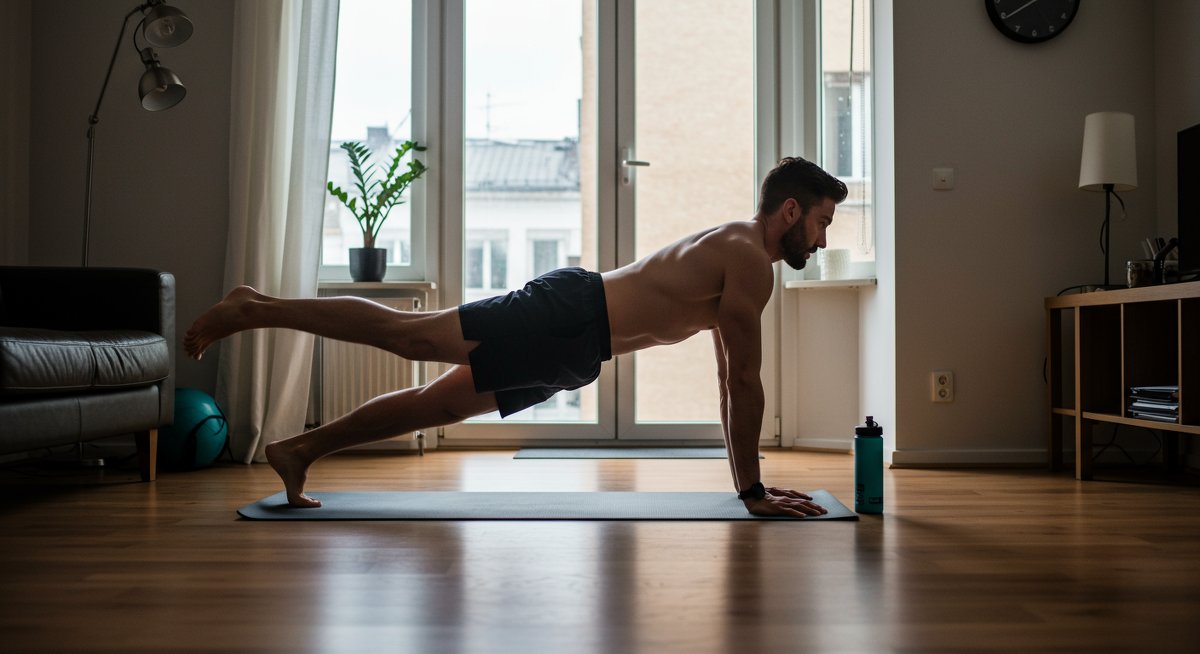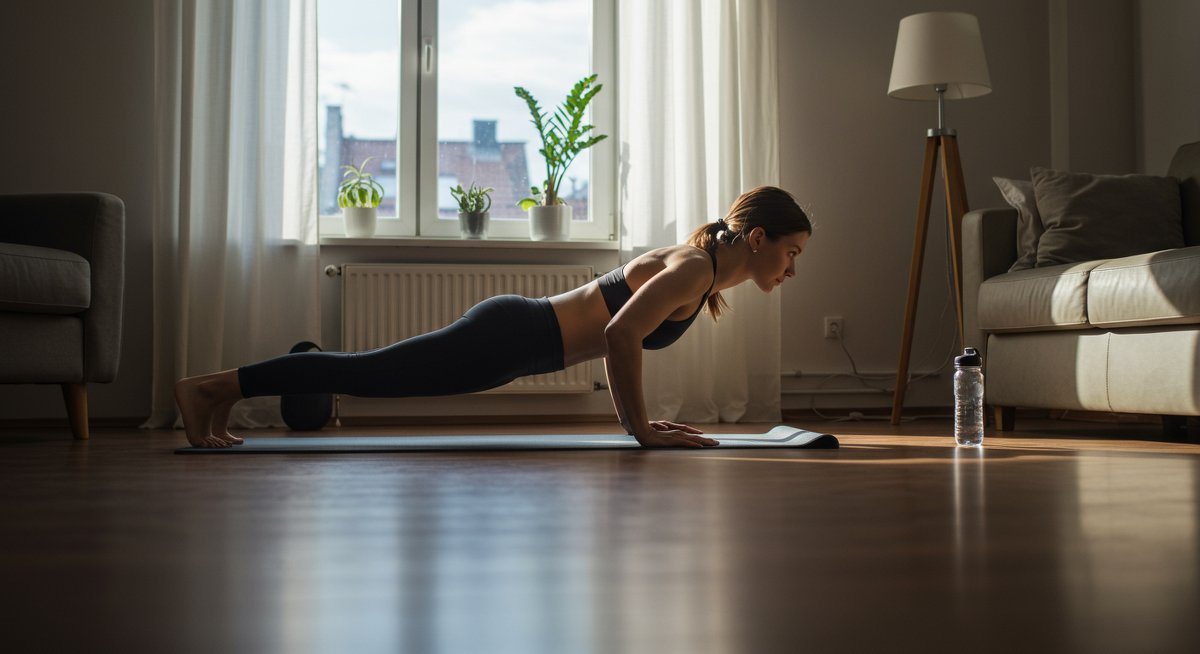Don't let a small apartment hold you back from achieving your fitness goals! This guide provides a simple, effective, and accessible workout plan designed specifically for those with limited living space. We'll dive into five powerful bodyweight exercises that require no equipment, making it easy to build strength and fitness from the comfort of your home. This is your starting point for a healthier lifestyle, no matter how compact your living situation. Let's get moving!

Why This Workout is Perfect for Home Beginners
Bodyweight exercises are a fantastic way to start your fitness journey. They're incredibly versatile, requiring no special equipment or gym membership. This means you can work out anytime, anywhere. For beginners, bodyweight exercises are ideal because they allow you to focus on proper form and build a solid foundation of strength before adding external resistance. They're also highly adaptable; you can easily modify them to match your current fitness level, ensuring a safe and effective workout.
- Accessibility: No equipment needed, so you can start immediately.
- Versatility: Adaptable to all fitness levels.
- Efficiency: Work out any time, anywhere. All you need is space to move.
Example 1: Imagine you’re a student with a packed schedule. You wake up late, and have only 20 minutes before your first class. You can easily squeeze in a quick bodyweight circuit right in your bedroom, boosting your energy levels for the day.
Example 2: You live in a studio apartment with minimal space. By strategically utilizing your living area, you can create a workout space. You can push your coffee table to the side for your workout.
Common mistakes to avoid: Rushing through the exercises, not focusing on form, and neglecting to warm up. A proper warm-up, even just a few minutes of dynamic stretching, can prevent injuries.
Essential Moves You'll Need
This workout routine consists of five fundamental bodyweight exercises. Each exercise targets different muscle groups, providing a balanced full-body workout. Focus on maintaining good form throughout each exercise to maximize effectiveness and minimize the risk of injury. Remember to breathe deeply and steadily throughout the exercises.
- Push-ups: A classic exercise that works your chest, triceps, and shoulders. Start in a plank position, hands shoulder-width apart. Lower your body until your chest touches the floor (or as close as possible), then push back up.
- Step-by-step Instructions:
- Assume a plank position, hands slightly wider than shoulder-width apart, fingers pointing forward.
- Engage your core and keep your body in a straight line from head to heels.
- Lower your chest towards the floor, bending your elbows.
- Maintain the straight line in your body
- Push back up to the starting position.
- Tips: Beginners can modify by doing push-ups on their knees.
- Step-by-step Instructions:
- Squats: This exercise targets your quads, hamstrings, and glutes. Stand with your feet shoulder-width apart, and lower your hips as if you're sitting in a chair, keeping your back straight. Return to the standing position.
- Step-by-step Instructions:
- Stand with your feet shoulder-width apart, toes pointing slightly outward.
- Keep your back straight, engage your core, and look forward.
- Lower your hips as if you’re sitting in a chair, keeping your weight on your heels.
- Go as low as you comfortably can while maintaining good form.
- Return to the starting position by pushing through your heels.
- Tips: Ensure your knees don't go past your toes. Focus on engaging your core.
- Step-by-step Instructions:
- Plank: An excellent core exercise. Hold a push-up position with your forearms on the ground. Maintain a straight line from head to heels, engaging your core muscles.
- Step-by-step Instructions:
- Start in a push-up position, but with your forearms on the ground and elbows under your shoulders.
- Engage your core by pulling your belly button towards your spine.
- Maintain a straight line from head to heels.
- Hold the position, breathing deeply.
- Do not let your hips sag.
- Tips: Ensure your body forms a straight line. Avoid arching your back.
- Step-by-step Instructions:
- Lunges: Targets your quads, hamstrings, and glutes. Step forward with one leg and lower your body until both knees are bent at a 90-degree angle. Push back up and repeat on the other side.
- Step-by-step Instructions:
- Stand with your feet shoulder-width apart.
- Take a step forward with one leg.
- Lower your body until both knees are bent at 90-degree angles.
- Push back up to the starting position.
- Repeat on the other side.
- Tips: Make sure your front knee doesn't go past your toes.
- Step-by-step Instructions:
- Crunches: Effective for working your abdominal muscles. Lie on your back with your knees bent. Place your hands behind your head and lift your upper body towards your knees, engaging your core.
- Step-by-step Instructions:
- Lie on your back with your knees bent and feet flat on the floor.
- Place your hands gently behind your head.
- Engage your core and lift your upper body towards your knees.
- Avoid pulling on your neck.
- Lower back down slowly.
- Tips: Focus on controlled movements and engaging your abs, not just pulling on your neck.
- Step-by-step Instructions:
Example 1: If you struggle with standard push-ups, modify them by doing them on your knees. This reduces the load and makes the exercise more accessible. You can also do them against a wall. This helps build strength.
Example 2: For squats, if you lack balance, you can hold onto a chair for support. This enables you to get the form right and improves your core.
Expert Tip: Remember to breathe. Exhale during the exertion phase (e.g., pushing up in a push-up) and inhale during the relaxing phase.

Tips for Success (e.g., common mistakes to avoid, modifications)
To get the most out of your bodyweight workout, keep these tips in mind. Proper form is paramount. It ensures that you are targeting the correct muscles and minimizes the risk of injury. Listen to your body. If you feel pain, stop and rest. There are variations for all fitness levels, so don't hesitate to modify exercises to suit your needs. Consistency is critical. Aim to workout regularly, even if it's just for a few minutes each day. Small, consistent efforts yield better results.
- Form Over Speed: Always prioritize correct form.
- Listen to Your Body: Rest when you need to.
- Modify Exercises: Adapt the exercises to your fitness level.
- Consistency is Key: Aim to workout regularly.
Example 1: Struggling with push-ups? Start with knee push-ups or wall push-ups. As you gain strength, transition to standard push-ups. This gradual progression is critical.
Example 2: Experiencing lower back pain during squats? Focus on engaging your core to protect your spine. If pain persists, modify your squat to a shallower depth or try a different exercise.
Common mistakes: Bouncing through exercises, not engaging core muscles, and not warming up. Always perform a quick warm-up before starting your workout.
Benefits and How It Helps Your Goals
Bodyweight exercises offer numerous benefits. They enhance your muscular strength, improve cardiovascular health, and increase your overall fitness level. These exercises boost your metabolism, helping you burn calories more efficiently and aiding in weight management. They also increase your endurance and flexibility, improving your overall athletic performance. The convenience of bodyweight exercises, which require no equipment, allows you to workout consistently, whether you're at home, on vacation, or anywhere. Bodyweight exercises not only improve physical health, but also mental health, reducing stress levels, and increasing self-confidence.
- Increased Strength: Builds muscle mass and strength.
- Cardiovascular Health: Improves heart health.
- Weight Management: Aids in burning calories.
- Flexibility: Increases overall mobility.
Example 1: You are trying to lose weight. By regularly performing these bodyweight exercises, you can burn calories and build muscle. This dual action supports weight loss, helping you achieve your goals.
Example 2: You want to be more active. These exercises will increase your energy levels, boost your cardiovascular health, and help you feel more energized during your daily activities.
How to Fit It Into Your Busy Schedule
One of the greatest advantages of bodyweight exercises is their flexibility. You can integrate them seamlessly into a busy schedule. Consider these time-saving strategies. Set a specific time each day, even if it's just for 20 minutes. Schedule your workouts like important appointments. Break your workout into smaller chunks throughout the day. Do a quick set of exercises during your lunch break or in the morning. Combine your workout with other activities, such as watching TV or listening to a podcast. Use this time to boost your energy. Remember, even short bursts of exercise are beneficial.
- Set a Schedule: Schedule your workouts like important appointments.
- Break it Up: Perform smaller workouts throughout the day.
- Multitask: Combine with other activities like watching TV.
- Be Consistent: Even short bursts of exercise are effective.
Example 1: You are a student. Squeeze in a quick workout session before or after your classes. A 20-minute workout is an ideal way to stay fit and clear your head.
Example 2: You work from home and have a busy schedule. Take a break from work and perform a quick bodyweight workout during your lunch break. This is a great way to boost energy levels.
Quick Warm-up and Cool-down
Before starting your workout, perform a brief warm-up to prepare your body for exercise. This can include dynamic stretches like arm circles, leg swings, and torso twists. After your workout, cool down with static stretches, holding each stretch for 15-30 seconds. This helps to improve flexibility and reduce muscle soreness. A proper warm-up and cool-down are crucial for preventing injuries and maximizing your results.
- Warm-up: Dynamic stretches.
- Cool-down: Static stretches.
- Hold stretches: 15-30 seconds.
Example 1: You start your workout with a few minutes of jumping jacks, high knees, and butt kicks. These dynamic stretches will increase your heart rate and get your muscles ready for action.
Example 2: After your workout, hold stretches, such as touching your toes and quad stretches. This helps improve flexibility and reduce muscle soreness.
Next Steps in Your Home Fitness Journey
Now that you've completed this beginner-friendly bodyweight workout, consider these next steps to advance your home fitness journey. Gradually increase the difficulty by adding more repetitions, sets, or trying more advanced variations. Explore other bodyweight exercises to challenge different muscle groups. Monitor your progress by tracking your workouts and setting realistic goals. You can track your workouts using a fitness app. Find a community. Join online fitness groups or forums. You can get support and share your progress. Continue to educate yourself. Read fitness articles, watch exercise videos, and seek advice from fitness professionals to deepen your knowledge and enhance your workouts. Remember that consistency, proper form, and listening to your body are key to long-term success.
- Progress Gradually: Increase reps/sets.
- Explore: Try other bodyweight exercises.
- Track Progress: Use a fitness tracker, or app.
- Join a Community: Find support and share progress.
Example 1: Increase the number of push-ups you can perform. Start with 3 sets of 10 and gradually work your way up to 3 sets of 15. Then, try more challenging variations such as diamond push-ups.
Example 2: Find a fitness community. Join online fitness groups or forums to connect with other fitness enthusiasts, share your progress, and gain motivation.